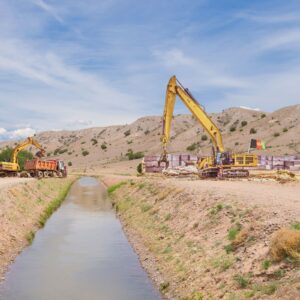
Graphic by Sarah Lu
By Thant Aung Paing
Edited by Mollie Montague and Courtney Schneider
About the China-Myanmar Economic Corridor
The China-Myanmar Economic Corridor (CMEC) is a combination of infrastructure, energy, and industrial projects along the economic corridor connecting Yangon (the commercial capital of Myanmar) and Kyaukphyu deep seaport in the Bay of Bengal to Kunming (the capital of Yunnan Province of China). The corridor has an inverted ‘Y’ shape (similar to ‘入’ in Chinese characters, meaning human). CMEC intends to connect economic centers in Europe, the Middle East, and beyond and is part of the Belt and Road Initiative (BRI). CMEC is also critical for the development of western Chinese provinces developing slower than the coastal provinces. China intends to access the Indian Ocean through the territory of Myanmar, which also adds to the strategic geopolitical importance, avoiding Malacca Strait, which connects the Indian Ocean and the South China Sea. The project involves building a deep seaport, railroads, and infrastructure in China and Myanmar.
2021 Myanmar Military Coup and CMEC
On February 1st, 2021, the Myanmar military staged a coup. They detained the civilian leaders and formed a military council in place of the civilian government in which the commander-in-chief of the military assumed the presidency of the military council. The military declared that the coup was carried out due to the election fraud of the civilian government and to prevent the civilian government from forcefully taking administrative power. Millions of people came to the streets, protested the military’s actions, and demanded the restoration of power to the civilian leaders. The military violently cracked down on these peaceful protests, resulting in thousands of civilian deaths and many thousands detained [1]. Afterward, the resisting forces turned to an armed struggle against the military government, expanding the longest civil war in the world that has been occurring since 1948. The civil war expanded into some areas that have been without armed conflict since World War II, forcing over two million people to leave their homes [2]. The coup was a derailment of both the democratic transition and the development of the country. According to the World Bank’s Economic Monitor Report, Myanmar’s economy is still struggling and subject to significant volatility and uncertainty [3].
In contrast to the public belief that the CMEC projects were stalled, they gained momentum under the civilian government before the military coup. The projects faced deadlock a few months after the coup, but the Chinese government continued to try to push them forward. However, with Myanmar facing a large-scale civil war, most rural areas under its control have joined anti-coup forces in an ongoing armed struggle against the military government. Additionally, Chinese investments throughout Myanmar are also prone to attacks by anti-coup forces. Anti-China sentiment is high in Myanmar because the public believes that China is supporting (or at least not condemning) the military government. Eighteen months after the coup, three hundred clashes were observed near areas where CMEC projects would be implemented [4]. Therefore, Chinese citizens working on these projects could be harmed in these conflicts if they were to expand the CMEC projects on the ground.
Just two months into the coup in March 2021, the Chinese Embassy in Myanmar announced that the anti-coup forces burned down thirty-two Chinese factories, although the exact number is thought to be exaggerated [5]. Moreover, the Chinese government released travel notices for Chinese citizens traveling in Myanmar, which might have consequences for implementing CMEC projects. The opposition declared that they had no intentions to harm foreign investments, but at least six direct attacks on Chinese investments out of the three hundred clashes occurred [6]. The anti-coup forces said they were not targeting the investments, but rather the military forces positioned within the perimeters of Chinese investments [7]. In November 2022, a Chinese citizen was injured in a military air strike on a mining facility in Karen State [8]. Afterwards, it was deemed that increasing the implementation rate of these projects would put the working teams at risk, and there would not be effective implementation of projects given the intensifying conflicts [9]. As the implementation rate of CMEC projects could not improve, China found ways to promote their projects and keep them on track in the public eye. As a result, Joint Transport Routes have been promoted by the Chinese Embassy in Myanmar.
The goal of Joint Transport Routes
There are currently three Joint Transport Routes according to the Chinese Embassy in Myanmar:
1) China (Yunnan) – Myanmar (Yangon) – Indian Ocean Container (Aug 2021)
2) Chongqing – Mohan – Vientiane – Thailand – Yangon (Apr 2022)
3) Guangxi -Yangon Maritime Route (Oct 2022) [10]
The primary goal of these transport routes is to show the Burmese people and the military that they are willing to implement CMEC in Myanmar no matter the social-political situation Myanmar faces. These trade routes are the divergence of the Kyaukphyu – Kunming railway, which connects the Kyaukphyu deep seaport in Myanmar to different parts of western Chinese provinces. Although construction on the Chinese side has nearly finished, those on the Myanmar side have yet to start. One thing to note is that oil and gas pipelines are already connecting Kyaukphyu to Yunnan Province of China. These pipelines contribute 6 percent of Chinese domestic crude oil consumption, and Myanmar obtains $1 per ton of oil passed through the pipelines [11]. They could also be expanded since these resources do not need to cross Malacca Strait, a strategic choke point for China.
CMEC and the Development of Myanmar
There are many concerns about the Chinese projects in Myanmar. First, the public sentiment in China was not favorable even before the coup. The coup compounded the sentiment as
1) People thought China approved of the coup,
2) Continuous Chinese protection of the military government at the United Nations and its related bodies, especially the Security Council, and
3) Transfer of submarines to the military in December 2021.
Although China has not explicitly stated that it approves the coup, it is important to note that the previous civilian government maintained a good relationship with China, a relationship that the military intends to change as it attempts to develop relationships with the neighboring countries and Russia. Despite the military government being isolated from the international community, they do not want to have China as the only dependable ally. At this point, China is a distant business partner rather than a close ally of the Myanmar military government.
Moreover, the Chinese projects in Myanmar have been facing social and environmental issues. The Chinese proposal to build a dam on the main river of Myanmar was opposed nationwide and postponed in 2011. The future of the project remains uncertain. The availability of job opportunities presents another social concern as Chinese companies bring workers from China instead of using the local workforce. As previously mentioned, there are reports of increasing clashes near potential areas of CMEC’s future projects. Therefore, it is questionable whether the development of CMEC projects brings stability and prosperity to Myanmar.
Myanmar also should have its development agenda set if they are expected to benefit from Chinese infrastructure projects. Implementation of the infrastructure projects on Myanmar’s soil does not necessarily mean that they will be beneficial for Myanmar. As Myanmar stretches geographically from north to south, it should focus on North-South infrastructure projects rather than CMEC, an East-West economic corridor. Myanmar (whether the military government or the opposition) may have its strategy for economic corridors, but these are not visible and distinct from the CMEC. If Myanmar does not have a strategic plan to merge with these projects, it would only remain in its least developed country status even with the potential infrastructure projects such as the CMEC.
Figure. Three New Joint Transport Routes between China and Myanmar
References
[1] Head, Jonathan. “Myanmar: Why Once Peaceful Protesters Are Now Choosing Violence.” BBC News. BBC, January 30, 2022. https://www.bbc.com/news/world-asia-60137053.
[2] ISP Myanmar. “2 million IDPs Since the Coup.” Facebook, February 4, 2023. https://www.facebook.com/ISPMyanmarpage/posts/pfbid02cuwW1w1THkojadmeQx83WQZfnYbeQwewcYHvNqg4txyzaueKQ72TtSZEwMP57UNl.
[3] World Bank Group. “Myanmar Economic Monitor January 2023: Navigating Uncertainty.” World Bank. World Bank Group, January 30, 2023. https://www.worldbank.org/en/country/myanmar/publication/myanmar-economic-monitor-january-2023-navigating-uncertainty.
[4] ISP Myanmar. “Clashes Double in Areas Close to Chinese Projects.” ISP, January 10, 2023. https://www.ispmyanmar.com/isp-data-matters/#images-10.
[5] Global Times. “Exclusive: 32 Chinese Factories in Yangon Have Been Attacked with Two Employees Injured: Embassy.” Global Times, March 15, 2021. https://www.globaltimes.cn/page/202103/1218404.shtml.
[6] ISP Myanmar. “China & Myanmar: Major Projects and Conflicts in the China-Myanmar Economic Corridor.” ISP Myanmar, May 20, 2022. https://www.ispmyanmar.com/china-myanmar-major-projects-and-conflicts-in-the-china-myanmar-economic-corridor/.
[7] The Irrawaddy. “China Tells Myanmar’s Civilian Govt to Spare Projects from Attack.” The Irrawaddy, January 24, 2022. https://www.irrawaddy.com/news/burma/china-tells-myanmars-civilian-govt-to-spare-projects-from-attack.html.
[8] Hein Htoo Zan. “Updated: Three Killed, Chinese National Injured as Myanmar Regime Jets Bomb Mine in KNU Territory.” The Irrawaddy, November 16, 2022. https://www.irrawaddy.com/news/burma/three-killed-as-myanmar-regime-jets-bomb-mine-in-knu-territory.html.
[9] Dr Kaho Yu. “China’s Pragmatic Myanmar Policy under Fire.” Verisk Maplecroft, April 2, 2021. https://www.maplecroft.com/insights/analysis/chinas-pragmatic-myanmar-policy-under-fire/.
[10] ISP Myanmar. “Three New China-Myanmar Cross-Border Trade Routes.” ISP Myanmar, January 16, 2023. https://www.ispmyanmar.com/three-new-china-myanmar-cross-border-trade-routes/.
[11] Li Yi. “China-Myanmar Oil and Gas Pipelines: A $5 Billion Problem.” China Dialogue, May 14, 2020. https://chinadialogue.net/en/energy/6183-china-myanmar-oil-and-gas-pipelines-a-5-billion-problem/.





